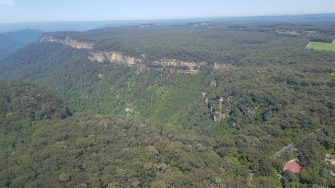
Date: Thursday, October 24, 2019
Project: Eastern Australian Waterbird Survey
Observers: Richard Kingsford & Paul Wainright
Pilot: Tim Dugan
We spent the night at Wagga, after surveying Dartmouth Dam and then in the morning surveyed Band 3, near Temora through to Moss Vale. Some areas here near Harden had had enough rain to at least grow enough grass to bale forage.
From Temora through to Crookwell, we surveyed some of the many small dams that pockmark this landscape. Unlike many other parts of our survey, this area was green and the dams were full. Many but not all the dams had a few waterbirds, including wood ducks and grey teal and the odd black duck.
As we flew over Crookwell, we have noticed more and more wind turbines generating the green energy we need.
It was here that we surveyed Pejar Dam, a water supply for nearby Goulburn. This had more than the usual numbers of cormorants and coot and was the fullest we have seen it in a number of years. The drought and its impacts seem to have spared a few places.
From here we then moved on over the Great Dividing Range on to survey one of Sydney’s dams for its water supply, Wingecarribee Reservoir. I don’t think I have surveyed this dam when it has had so little water. It was drying back from the top much more than in past years. It is still very poor waterbird habitat with just a few swans, cormorants and pelicans.
We finally finished by surveying Fitzroy Falls Dam which overlooks the cliffs of the Great Dividing Range down to the east coast.
Next week, we will be surveying the River Murray and its major wetlands, right down to the Murray Mouth.
